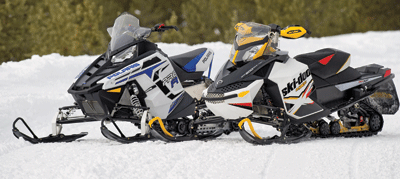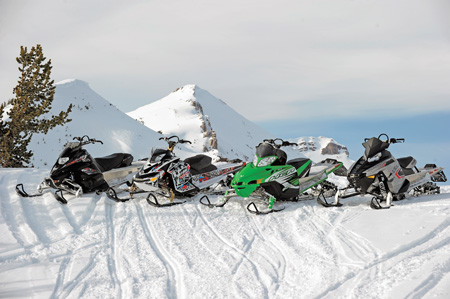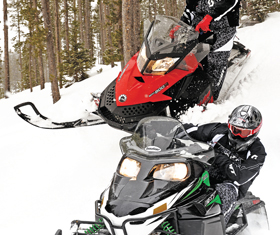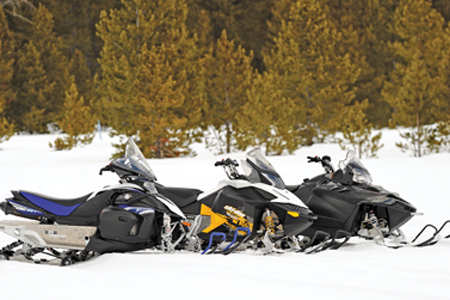Four-stroke snowmobile engines are perceived to offer better fuel economy, smoother and quieter operation and more reliability than a two-stroke. They’re also assumed to be heavy, sluggish and produce less horsepower per cubic inch.
While performance four-stroke snowmobiles have become even better since Yamaha introduced the first one with its RX-1 in 2003, there’s still a lot of snowmobilers who aren’t ready to embrace the technology. They want to stick with the “good ol’ two-stroke.”
We’re big fans of two-stroke engines because of their quick power delivery, lightweight performance and adrenaline-pumping exhaust note. But with better four-stroke engines and improved chassis to house those powerplants, two-stroke die-hards can’t help but respect four-stroke technology.
We ran the Arctic Cat Z1, Polaris IQ Turbo Dragon, Ski-Doo MX Z 1200 TNT and Yamaha FX Nytro side by side to see how the four mid-weight performance four-strokes compare. During the ride, editors Tim Erickson and Andy Swanson and contributing editor Jeff Oberg tracked their impressions of how the sleds performed and where they could improve.
Each of the machines proved to have redeeming qualities, but some received more positive marks than others. Read the editors’ trailside notes to find out where they disagreed, how your favorite brand’s four-stroke stacked up and to help you decide if this is the year you trade in your two-stroke.
Arctic Cat Z1
The 1056cc, twin-cylinder Suzuki engine debuted in 2007. It pulls fuel through a pair of 48mm throttle bodies and it’s rated at 125 hp. RydeFX shocks are bolted throughout the Z1’s front and rear suspensions. Arctic Cat does not provide a weight listing for the Z1. At $9,549, it’s the least-expensive sled of the four.
Polaris IQ Turbo Dragon
This season marks the fourth year of the turbo-powered four-stroke engine from Polaris. It’s a fuel-injected, 750cc twin-cylinder Weber powerplant that Polaris rates at 140 hp. The IQ Turbo Dragon has RydeFX Air 2.0 shocks over the skis and gas shocks from RydeFX out back, too. The rear track shock is a compression adjustable clicker. Polaris lists the sled’s dry weight at 580 pounds. It retails for $10,499.
Ski-Doo MX Z 1200 TNT
 Ski-Doo’s four-stroke engine is a rookie this year. It’s a three-cylinder, 1170cc Rotax rated at 130 hp. It has four valves per cylinder and one, 52mm throttle body. The new REV-XR body was specially designed to house the engine. It has Kayaba take-apart aluminum shocks all the way around. Ski-Doo lists the sled’s dry weight at 499 pounds. It retails for $10,899.
Ski-Doo’s four-stroke engine is a rookie this year. It’s a three-cylinder, 1170cc Rotax rated at 130 hp. It has four valves per cylinder and one, 52mm throttle body. The new REV-XR body was specially designed to house the engine. It has Kayaba take-apart aluminum shocks all the way around. Ski-Doo lists the sled’s dry weight at 499 pounds. It retails for $10,899.
Yamaha FX Nytro
The Genesis 130FI is a three-cylinder 1049cc engine built by Yamaha. Back for its second season, it has three, 41mm Mikuni throttle bodies and it’s rated at 130 hp. The FX Nytro’s front suspension has dual-clicker gas shocks. The rear suspension has Soqi aluminum gas shocks with a piggyback compression clicker on the rear track shock. Yamaha lists the sled at 521 pounds. It retails for $10,199.
Arctic Cat Z1
Arctic Cat was the first to respond to Yamaha’s performance four-stroke when it introduced the T660 Turbo in 2004. While the sled was fast, it had shortcomings. The company’s current four-stroke powerplant is a good blend of power and polite manners; it’s a perfect match with the comfortable Twin Spar chassis. Unlike the T660, the Z1 uses a purpose-built snowmobile engine.
Tim Erickson, editor-in-chief
- Engine is pretty responsive with an OK sound; a little too industrial, though.
- Front end feels very planted, yet retains the light steering of Cat’s Twin Spar chassis. Conditions are a bit slippery. The front isn’t pushing through turns. It has predictable, stable handling but the back trying to pass the front is indicative of front-end weight. But in the bumps and riding it I don’t feel the mass as much.
- Heavy-ass front end, but there could be something gained with weight transfer adjustments, too. Needs more transfer/traction, especially noticeable on uphills with lots of track spin.
- I haven’t ridden the Poo yet, but no comparison for ride quality. This sled kicks butt over the Doo and Yammie. Big, long, but super comfy. My favorite.
- The sled has decent wind protection, ergos are good. I feel tall on this sled. No adjustable bars this year? That feature might be missed by some people. The cheap flap that closes off where the adjuster used to be is a mark against an otherwise clean, great finish.Andy Swanson, managing editor
- The Z1 has a great ride-quality over the ripple bumps. I really liked the Z1’s new, narrower seat and console. The sled is more manageable and the chassis, as a whole, doesn’t feel as awkward because of this update.
- There’s more engine noise from the Cat than any other sled in the group, and it’s the most industrial sounding powerplant of the bunch.
- The Z1 is the couch of this group. The Slide Action suspension erases the bumps of a rough trail. I can feel the bumps in the front, but overall it’s the most comfortable ride of all four sleds. The steering was slower to engage than the Ski-Doo.
- The sled feels surprisingly light. In terms of engine performance, the Z1’s twin works well and has good power.
- I would classify the Cat as the most touring-esque sled here.Jeff Oberg, contributing editor

- This is a powerful, hard-pulling sled. It needs a cooler sound to match the animal-like power, though. Throttle response was fair, but acceleration was sneaky fast. Pulls harder, and harder and harder. Where does it end?
- The seat is soft and comfortable. However, the transition from side to side for cornering exposed a sharp edge on the seat. When sliding my butt to the edge, I felt like I was falling off a square edge.
- Comfortable, plush ride. I didn’t encounter any large bumps during my turn on board to see if it bottomed out. The rear skid worked well on the small bumps.
- The seat was very slippery, especially with a little snow dust. Minimal visibility of skis and trail directly in front of sled. Great storage for lots of stuff.Polaris IQ Turbo Dragon
The Dragon is the only sled of this bunch that uses artificial aspiration to feed the engine extra air and to produce more power. The turbo system will “burst” the base four-stroke’s peak output as high as 150 hp during acceleration. Sales of four-stroke sleds leveled off industry-wide last season, according to Polaris Snowmobiles General Manager Scott Swenson. With the other manufacturers charging forward with new four-stroke engines, it will be interesting to see how Polaris handles the four-stroke market in the future.
Tim Erickson, editor-in-chief
- Good power with very little lag, so it’s always right there. It’s the most powerful, and feels the most responsive, fastest. Quick, trademark Polaris backshifting. Not much need to use brakes, but not as much engine braking as some others.
- Decent handling, but it steers heavy. On sharp curves I’m on the bar ends/hooks for added leverage. Rides the heaviest, most of it due to the steering.
- Front suspension works better than the rear. Had a few harsh, sudden kicks off the top of some bumps; probably the skid unloading as I hit the face of a bump and it sprung me.
- Feet were moving all over the place and I jabbed my knee into a rough part of the console. Easy to move around and lean off.Andy Swanson, managing editor
- The Dragon had a familiar feel on the trail. It was much like other IQ trail sleds. If the rear end lost traction, the sled remained controllable and predictable so I could steer through the section with confidence.
- The engine is quiet, so I could hear the track more than the powerplant. It spun 5000 rpm at 50 mph with a strong pull at 7500 rpm. It was difficult to drive the Dragon smoothly because the turbo power came on hard at about 6500 to 7000 rpm.
- Steering and handling is solid, but it contributes to the machine’s heavier-than-the-rest feel. The sled felt clumsier than the Doo. Part of the reason is because the seat felt too low; its feel was reminiscent of an EDGE-based sled.
- The Polaris should be called an IQ, not a Dragon. Polaris four-stroke customers don’t want — or need — Dragon extras like high-performance shocks, a short windshield and aggressive graphics.
- The Dragon felt the most dated of all four.Jeff Oberg, contributing editor

- Fun to drive, pulls hard. Great throttle response, especially when accelerating from 30 mph.
- Noise from under the hood has got to go. Annoying! I could hear the turbo spool when I was on a different sled and others in the group were riding it.
- Front half of the suspension worked very well. However, I easily crashed through the skid.
- Good visibility. I can see the skis and trail in front of sled. Needs more running board traction. It has a little storage and that’s better than no storage like so many other sleds these days.Ski-Doo MX Z 1200 TNT
Ski-Doo was the last holdout to build a performance four-stroke sled, and with the release of the company’s two-stroke E-TEC technology that provides leading fuel economy and low emissions, 2009 seemed like an odd time to do it. So, why did the company come out with a four-stroke this year? According to Ski-Doo Marketing Director Francois Tremblay, there’s a market demand. “The only credible four-stroke snowmobile manufacturer is Yamaha,” he said at Ski-Doo’s 2009 snowmobile media introduction. Tremblay predicted that four-strokes could represent 39 percent of new sled sales for model year 2009, and Ski-Doo wants a piece of that pie.
AdvertisementTim Erickson, editor-in-chief
- New kid does just OK. I’m not terribly impressed with this engine. Great first effort, but it isn’t as responsive or feel as powerful and linear as the Yamaha. Stabby throttle at corner speeds, a very on/off power delivery. Hard to find that neutral “coasting” zone on the trigger.
- If I sit way forward, makes the rear really light — more noticeable than other sleds. Traction is no better/worse than the Z1, but on the Doo I feel like I steer it a lot from the rear, using the front weight to stick the skis, square the corner and throw out the rear.
- Good ergos for any type of driving you want to do. For its weight on paper, I thought it would drive lighter than it does in the rough. Wow, four-strokes are heavy! I can feel it. Seems to be little anyone can do to get around that fact, even in a lightweight chassis.Andy Swanson, managing editor
- The Ski-Doo has a sportier feel than the Cat or Yamaha. If I only based my impression on weight, I can’t tell the MX Z is a four-stroke. The sled is agile and controllable.
- Regarding engine performance, it has a turbo lag feel to it at clutch engagement. I push the throttle lever and it reacts a bit, but it takes another fraction of a second for the sled to really go, to impress that it’s making power. Once it’s up and running, power feels much like a 600 two-stroke.
- The MX Z is the sportiest of these four sleds.Jeff Oberg, contributing editor
- Chassis is predictable and absorbs the bumps well. Transfers a lot of weight to the front when braking and decelerating. This problem might be eliminated with more front-spring preload.

- The clutching provides smooth acceleration in all ranges. The engine produces very little noise for the driver.
- The transition from braking to acceleration has too much lag time. Engine braking into the corners worked great, but acceleration wasn’t as quick as the others when coming out of the corners. This is not a shoot-from-corner-to-corner type of sled. It pulls hard when on long straightaways, though.
- My expectation was for a lightweight feel, but it rides and looks like a pregnant REV-XP. Not as nimble as a two-stroke XP chassis.
- The sled rides heavy on the front. When hitting the throttle over rollers, the front end would not come up like lighter sleds.Yamaha FX Nytro
Yamaha has earned the Snow Goer Snowmobile of the Year award three times since 2003, and all of the sleds were powered by four-stroke engines. The award-winning machines had new technology, were innovative and moved the sport of snowmobiling forward. Yamaha is the only four-stroke sled builder to utilize rear-exit exhaust systems. From the ground up, the sleds are built around that design principle, and the layout contributes to their unique exhaust note and better weight distribution. If not for those ground-breaking snowmobiles, we wouldn’t have the other performance four-stroke sleds to compare against Yamaha.
Tim Erickson, editor-in-chief
- The Nytro has easier throttle transition. Much smoother power than the Ski-Doo.
- I keep sliding forward on the seat. Top of the footwells lock in nice but feel too thin. Too much of a pressure point on the top of my feet. Easy, comfortable sled to move around on, otherwise.
- Front suspension is better than the rear. Rear feels lazy in the fast, rapid stutters; like it tries too hard to keep up and it packs in. Is it shock valving? Usually I feel lots of spring in Yamaha sleds. This feels opposite.
- Still wants to stand up now and then, but it corners a lot flatter than last year’s Nytros.Andy Swanson, managing editor
- The Nytro has the best engine. It has good power and it delivers power smoothly and predictably.
- For trails that were tight and twisty, the handle bar ended up in my lap on sharp turns. At this point, the only other sled of the group I had driven was the Dragon, but the Nytro pushed more on the trail with light snow cover. I wasn’t as smooth through corners while driving the Nytro, either, and I had to rely on the brake to keep the sled under control.
- The Nytro has a comfortable, cushy seat. Through the rough, I preferred it over the Dragon mostly because its ergonomics are better. I could stand easier or hover over the seat more comfortably.
- I heard a few hard cracks and crunches over the chop at wide-open throttle, but the skid didn’t bottom. The front end hunted and pecked more than the others and I almost hooked a ski on a tree when the rear end washed out. Whew!
- The Yamaha is the most fun and has the most playful performance of these four-stroke sleds.Jeff Oberg, contributing editor
- The Nytro’s cool engine and exhaust sound never gets old.
- Handles flat, but pushes in the corners. It worked best when staying at a steady pace. If ripping from corner to corner, the sled wasn’t as stable. Skis seek ruts.
- Front suspension outperforms the rear. Skid was harsh in small stutters. The rear end of the sled felt loose; could use more weight transfer to the back. When riding between 30 and 50 mph, it seems I should’ve felt more force pushing me back on the seat.
- LED taillight provides great visibility, especially when braking. This was most noticeable in the snow dust.
- The higher windshield is a significant improvement over last year to keep wind off the driver and the windshield flares are improved for driver warmth. The seat is comfortable and offers an easy transition from side to side for aggressive cornering and the cab has plenty of room to move around.
- This is best-in-class for cool factor, performance and sporty look and feel.





Pingback: What Is the Life Expectancy of a Snowmobile? – Outdoor Troop